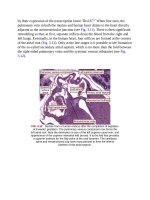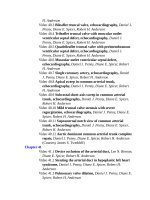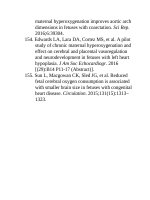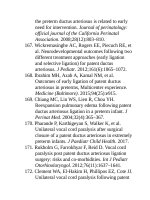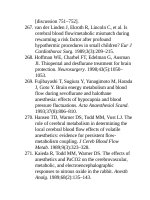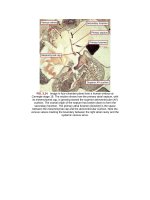Andersons pediatric cardiology 1089
Bạn đang xem bản rút gọn của tài liệu. Xem và tải ngay bản đầy đủ của tài liệu tại đây (61.14 KB, 3 trang )
consequencesarerare.Otherpotentiallyimportantcomplicationsaredisturbance
toflowintheproximalleftpulmonaryarteryordescendingaortafroma
protrudingdevice,hemolysisfromhigh-velocityresidualshunting,femoral
arterialorvenousthrombosisrelatedtovascularaccess,andinfection.
Regardlessoftechniqueofclosure,theclinicaldiagnosisshouldbeconfirmed
noninvasivelypriortocatheterizationbycolorDopplerechocardiography,with
particularemphasisplacedonthepresenceofassociatedlesionsthatcould
complicatetheprocedure,suchasazygoscontinuationoftheinferiorcavalvein,
presenceofanadditionallesionthatrequiressurgicalintervention,orthe
presenceofpulmonaryvasculardisease.Specialattentionshouldalsobe
directedtothetransversearchandisthmicregion,toexcludeunsuspected
coarctation.Althoughinitiallytheprocedurewasbestsuitedforpatients
weighingmorethan6kg,improveddevicedesignandoperatorexperiencehas
allowedapplicationeventotheverylowbirthweightinfant(seelater).
Nevertheless,insmallerinfants,difficultiesinpositioning,leftpulmonary
arterialstenosis,oraorticobstructionmayoccur.Thereisconsiderablevariation
inproceduraldetailsaspracticedamongcenters,suchastheuseofcoincident
arterialcannulationandthenumberandtypeofangiograms.However,the
majorityofprocedurescanbeperformedinanoutpatientsetting,withdischarge
ontheafternoonofinsertion.
PatencyoftheArterialDuctinthePremature
Infant(seealsoChapter15)
Duringthepast4decades,therehasbeenamarkedincreaseinpremature
deliveryinmany,butnotall,developedcountries.Althoughthereasonsforthis
areobscure,theincreasehasbeenmetbythedevelopmentofneonatalintensive
careunitsand,morerecently,unitsforpregnanciesconsideredtobeathighrisk.
Theartandscienceofcaringfortheextremelyprematureinfanthavedeveloped
tothepointwheresurvivalofinfantsweighingnomorethan500gisnot
uncommon.
Pathophysiology
Thepresenceofapatentarterialductisacommonclinicalprobleminthe
prematureneonateandthoseofextremelowbirthweight,beingfoundin65%of
neonateswithabirthweightlessthan1000gandoftenassociatedwithvarious
neonatalmorbidities.163Thereareseveralfactorsthattendtopreventclosureof
thearterialductintheimmatureinfantbecauseboththesensitivitytooxygen
andtheactionofprostaglandinareagedependent164andtherelaxantmechanism
ofprostaglandinismoreactiveintheimmatureduct.164–166Thetypeand
durationofventilatorysupport,drugtherapy,phototherapy,bloodtransfusions,
anddiuretics,undoubtedlyaccountforthewidevariationsinincidencereported
fromdifferentinstitutions.
Thepulmonaryvascularresistanceislowerintheprematurethanthefull-term
child,duetotherapidincreaseinnumberofmuscularizedpulmonaryvessels.
Thevesselsoftheimmaturelungalsoconstrictlessforagivenstimulusthanat
term.Constrictivestimulusesincludehypoxia,acidemia,andpossibly
circulatingvasoactivepeptidesandprostaglandins,frequentcomorbiditiesinthe
respiratorydistresssyndromes.Thesefactorsrendertheimmatureinfant
especiallyliabletodevelopleft-to-rightshuntingwhentheductremainspatent.
Systemicvasoconstriction,sooftenafeatureofthesickprematureinfant,may
furtherencouragetheshuntandexacerbatetherespiratorydistresssyndrome.167
Theimmatureinfantisfurtherhandicappedbyitsreducedcardiacreserve.The
increasedvolumeoverloadsecondarytoaleft-to-rightshuntproducesan
inordinateriseinleftventricularend-diastolicpressureandaconcomitantrisein
pulmonaryvenouspressure.Withalargeleft-to-rightshuntthroughtheduct,
systemicdiastolicpressurefalls,compromisingtheflowthroughthecoronary
arteries,which,combinedwithashorteneddiastolebecauseoftachycardiaand
raisedventricularend-diastolicpressures,predisposestosubendocardial
ischemia.Systemichypoxiasecondarytopulmonaryproblems,combinedwitha
reducedcapacitytocarryanddeliveroxygenduetoanemiaandfetal
hemoglobin,furtherimpairsmyocardialfunctionandisreflectedinischemic
changesintheelectrocardiogramfrequentlyseeninthesickprematureinfant.
Otherimportantcirculations,suchasthoseofthegut,kidneys,andbrain,maybe
compromisedbythehemodynamicchangesrelatedinparttothediastolicrunoff
fromtheaortaintothepulmonaryarteries,withtheductanetiologicfactorin
necrotizingenterocolitisandcerebralhemorrhage.
ClinicalFeatures
Theclinicalpictureofpatencyoftheductintheprematureinfantdependsonthe
sizeoftheleft-to-rightshunt,onthematurityoftheheartandlungstoadjustto
theincreasedvolumeload,andonthepresenceofotherpathologies,whichmay
obscurethemoretypicalfindings.Becausemanyprematureinfantshave
respiratorydistresssyndrome,theuseofsurfactantwillmodifytheclinical
expressionofductalshuntingbyinfluencingpulmonaryvascularresistance.The
presenceofasignificantductcanoftenbedifficulttorecognizeevenby
experiencedclinicians,andechocardiographyisofgreatvalue.Threedistinct
patternsofclinicalpresentationmaybeobserved.168
AbsenceofPulmonaryDisease
Theseinfantsgenerallyhavebirthweightsexceeding1500g.However,smaller
infantsmaybeencounteredwhosemothersmayhavereceivedsteroidsor
themselvesreceivedsurfactant.Sometimesasystolicmurmurisdetectedinthe
firstweekoflife.Thisbecomeslouderandlongeraspulmonaryvascular
resistancefallsandeventuallyspillsintoearlydiastole.Themurmurisbest
heardinthesecondandthirdleftinterspaces.Itisassociatedwithaccentuation
ofpulmonaryclosure,withthetypicalcontinuousmurmurasheardinolder
childrenusuallynotbeingpresent.Iftheshuntbecomeslarge,theprecordium
becomeshyperactive,thepulsepressurewide,andtheperipheralpulses
bounding.Anapicalthirdsoundmayalsooccurassociatedwithadiastolicflow
murmur.Iftheleftventriclefails,tachycardiaandtachypneadevelop,andmoist
soundscanbeheardinthechest.Apneaandbradycardiamaycomplicatesevere
leftventricularfailure.Hepatomegalymayonlydeveloplate.Mostinfantsinthis
groupdonotdevelopmassiveshuntsandcanbemanagedbysimplemedical
means.Theductclosesspontaneouslyinthemajorityatanageapproximatingto
fullterm.Theseolderinfantstendtorespondlesswelltoindomethacinthan
moreimmatureinfantsdo.
InfantsRecoveringFromLungDisease
Left-to-rightductalshuntingmaydevelopininfantsrecoveringfromrespiratory
distresssyndrome.Usuallytheyweighbetween1000and1500g.Mostprobably
theductispatentfrombirth,andleft-to-rightshuntingdevelopsonlyduring
recoverywhenpulmonaryvascularresistancefalls.Atthistime,increased
administrationoffluidsmayfurtheraggravatetheloadingeffectsoftheshunton
leftventricularfunction.Manyoftheseinfantsarestillmaintainedon
mechanicalventilatorsorcontinuouspositiveairwaypressure,whenshunting
firstdevelops.Becauseofthis,theinitialsystolicmurmurmaybedifficultto
